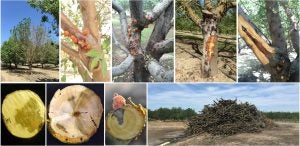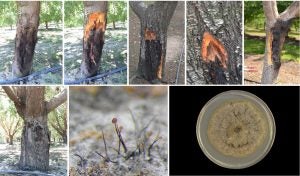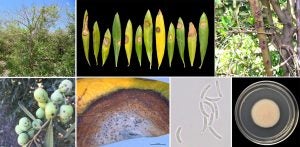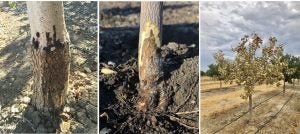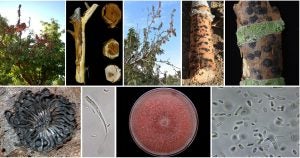Epidemiology and Management of Red Leaf Blotch of Almond in California
Red leaf blotch (RLB), caused by the fungal pathogen Polystigma amygdalinum, recently emerged in California and is now widespread throughout the Northern San Joaquin Valley. The emergence of this new, exotic and invasive disease in California represents a serious threat to the industry as it will affect the productivity of orchards as well as the profitability of almond farming. The present project proposes to investigate various aspects of the new disease biology including the disease etiology and epidemiology, the disease cycle and environmental conditions favoring the pathogen spore dispersal, the host susceptibility as well as biological and chemical control strategies to limit its spread. This project will provide molecular tools for disease detection and diagnostic to support farm advisors, PCAs and growers working with almond. Material illustrating the disease signs and symptoms will be provided to support field diagnostic and disease detection in orchards. Additional benefits of this research will include a complete understanding of the disease biology including timing of spore (inoculum) release in orchards and risk period for infection of almond trees as well as some knowledge of environmental conditions favoring disease spread. Finally, the present research will provide knowledge of the best timing for fungicide applications as well as fungicide efficacy data for various chemistries (FRAC groups) and diverse biological control products.
Trunk and Scaffold Canker Diseases of Almond in California
Trunk and Scaffold Canker Diseases (TSCD) of almond cause significant yield and tree losses within orchards in California. Symptoms of TSCD include discoloration of vascular tissues, wood necrosis and gumming. Dieback of scaffold branches can occur and eventually the whole tree may die. Canker diseases are rather common in older orchards but concerns have raised among growers and farm advisors as TSCD diseases are also being detected in relatively young trees. In California, the main causes of TSCD are still poorly understood and diagnosis has been particularly difficult. Poor understanding of TSCD has also hindered attempts to control them. Our research efforts intend to characterized the main fungi associated with TSCD in California, evaluate their pathogenicity in almond cultivars and provide control strategies by testing various fungicides, bio-control agents and wound sealants for pruning wounds protection.
Implementing a phylogenomic approach (i.e. whole genome sequence analyses and evolutionary reconstructions) to characterize Pseudomonas syringae from almond and other stone fruits
We are using whole genome sequence analyses to investigate the diversity of Pseudomonas spp. associated with almond and other stone fruit in California. Our goals are to better understand the epidemiology and ecology of this group of plant pathogenic bacteria, as well as to establish a framework for disease management.
Re-examination of Ceratocystis canker of almond in California
Ceratocystis canker of almond caused by Ceratocystis fimbriata occurs throughout almond production areas of California. The canker develops on trunks and branches of trees that have been damaged by tractors and harvesting equipment. There is a strong correlation between shaker damage and Ceratocystis canker presence. The fungus is spread by sap-feeding beetles and the resulting cankers can girdle the limbs, scaffolds and trunks of almond trees. Despite its prevalence in California orchards, little research has been conducted on the pathogen’s biology and dispersal in California. The lack of research may be due to the difficulty in culturing this microorganism and because of this, diagnosis of this disease might have been overlooked. The lack of chemical or biological control practices is becoming problematic as Ceratocystis canker is one of the most common diseases found in California almond orchards. Research on this disease is coming at a critical time as the almond industry in California is growing rapidly. The purpose of our research is to improve diagnostics of Ceratocystis canker of almond, determine the population genetic diversity and spatial distribution of Ceratocystis fimbriata in almond orchards , and define management practices using cultural and chemical/biological solutions.
Biology and control of Neofabraea leaf spot, branch canker and twig dieback of oil olives in California
During the winter and spring of 2016, severe defoliation as well as twig dieback and branch cankers were observed in super-high-density oil olive orchards in California. Cankers developed at wounds caused by mechanical harvest. Necrotic leaf spots were also detected commonly within the diseased orchards. Results of isolation revealed two species of Neofabraea to be consistently isolated from the symptomatic tissues. To date little is known about Neofabraea disease in olive. The emergence of this new disease in California olives is of major concern to growers and constitutes a serious threat to the industry’s productivity. The present project proposes to investigate various aspects of the new disease biology including disease etiology and epidemiology, pathogen biology, host susceptibility as well as strategies to control the disease and limit its spread.
Investigating soil borne diseases of pistachio in California
We are investigating soil borne diseases of pistachio including Phytophthora crown and root. Our current objectives are to develop management strategies against Phytophthora.
Etiology and management of sweet cherry canker diseases
Our work on sweet cherry aim to expand our understanding of the biology and epidemiology of fungal canker diseases affecting sweet cherry, and improved control strategies. We are currently investigating the effect of temperature on fungal spore germination and mycelial growth, as well as the seasonal susceptibility of pruning wounds.

